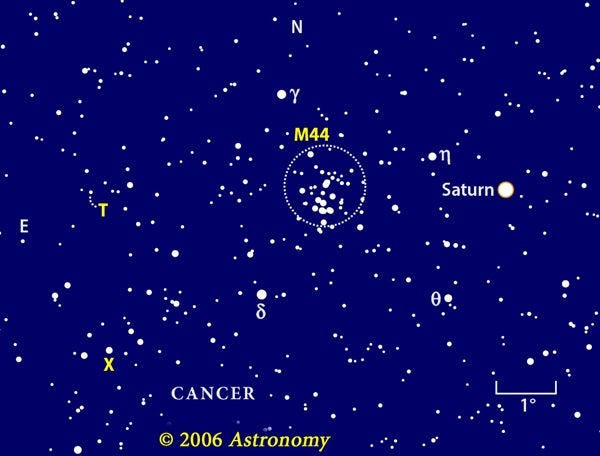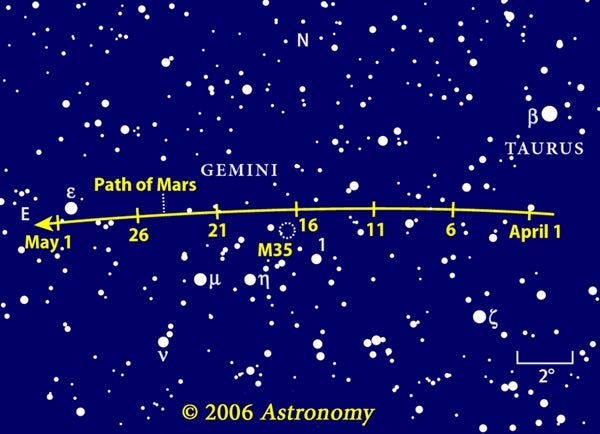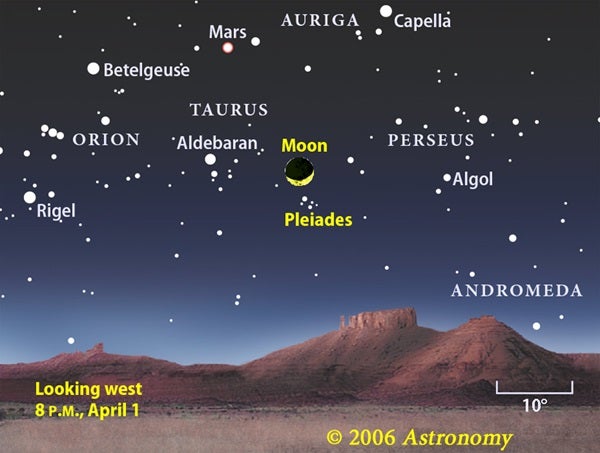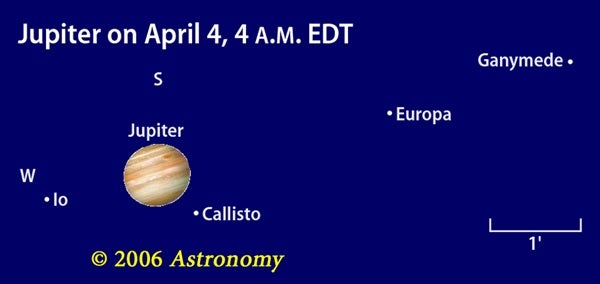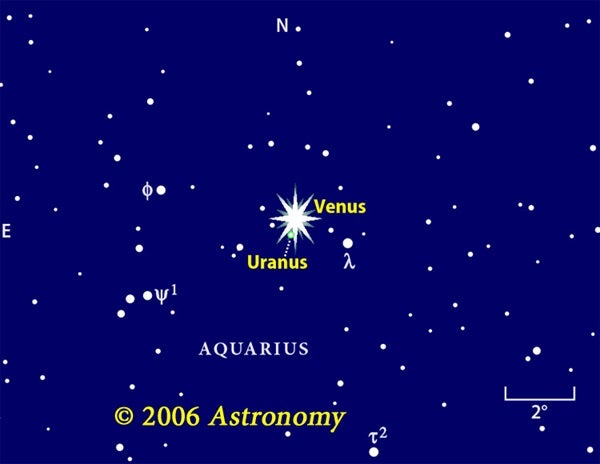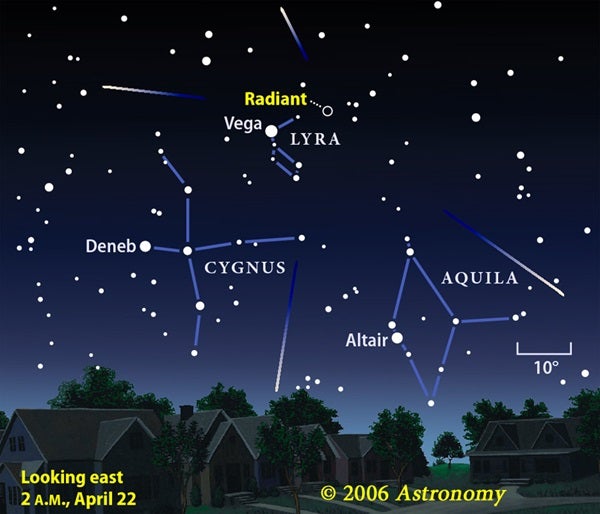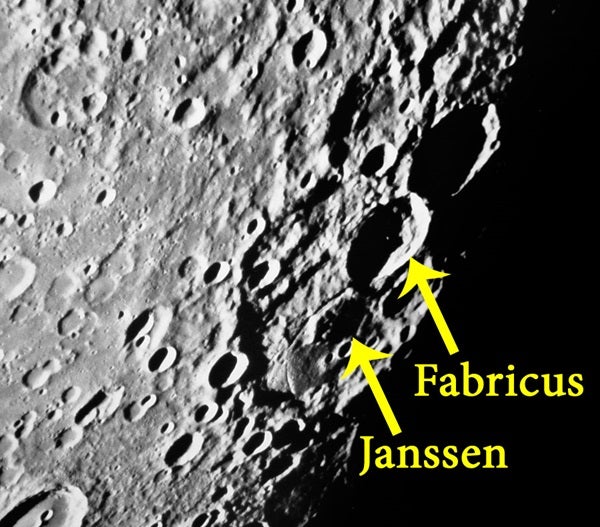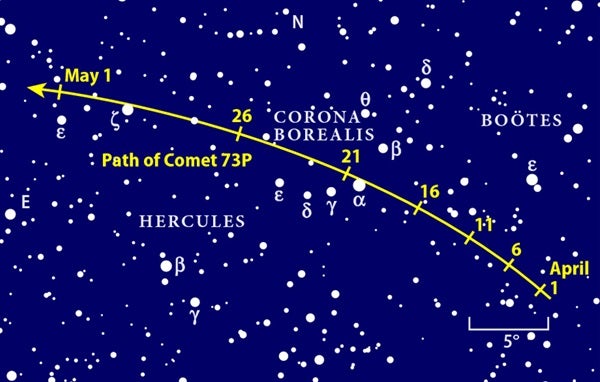The ashen light filling out the Moon’s disk comes from sunlight reflecting off Earth’s dayside up to the Moon, and then back to us. Literally, the Moon is bathed in earthshine. If it appears particularly bright, you can trace some lunar seas and bright craters through a small telescope.
The bright yellow, steady “star” high in the south is Saturn. Viewing the planet’s small disk surrounded by rings is a sight beyond compare, even in the smallest telescope. Do you see a faint point of light just to the side? This dot is actually the big moon Titan. A 3-inch scope also reveals the moon Rhea, while a 6-inch pulls in Tethys, Dione, and the bizarre, two-faced Iapetus.
Use the circular sky chart in the foldout at right (after the poster) to locate Mars. The ruddy planet has faded considerably since its brilliant peak last autumn. It continues to drift eastward against a backdrop of winter constellations, two of which happen to contain stars of similar color. Both Aldebaran and Betelgeuse lie beneath Mars, and together the trio forms an almost perfect equilateral triangle around April 4. Unfortunately, Mars appears so small now that no details show up telescopically.
In contrast, Jupiter is huge, both at the eyepiece and in reality. The king of planets rises in the southeast in early evening. Despite the typical poor conditions in Earth’s atmosphere so close to the horizon, Jupiter’s cream-colored disk shows detail. Look for two parallel bands of purple brown, the primary belts of its cloud system. Will all four bright moons be visible? Have a look, then use the foldout section to identify each dot. Remember that a scope with a diagonal will flip the image left to right.
As our lunar companion makes its monthly journey around the sky, it passes above Mars on the 3rd, over Saturn on the 6th, and reaches Jupiter’s area of sky on the 14th. During the following week, it plunges southward and its phase wanes, leaving the evening sky Moon-free for observing.
Avoiding the spray of light from both the Moon and any nearby city is important for appreciating the night sky’s beauty and getting the most out of your eyes and telescope. Comet 73P/Schwassmann-Wachmann 3 should be sprouting a tail and growing bigger, but you won’t see its gray light against city skyglow. If we’re lucky, the comet will flare in brightness as it breaks apart — only time will tell.
Commonly called “shooting stars,” meteors are swift streaks of light created when ancient comet debris burns up high in our atmosphere. During an annual meteor shower, like April’s Lyrids, you might see a dozen or two per hour, but only from a dark site. This year, the Lyrids peak near dawn Saturday morning the 22nd. Gather in a group, bundle up against the crisp late-night air, and enjoy the stellar show.
Tracking variables
Once you get past luminaries like Aldebaran, Betelgeuse, and Antares, orange-red stars seem hard to come by. That’s true only for visual observers like us, however — big telescopes with sensitive equipment detect faint red stars by the truckload because they’re the most common type in the galaxy.
Without exception, bright orange-red stars vary in brightness. And they’re bright only because they lie reasonably near. As variables go through their cycles, you can watch them shift from a brighter orange to a fainter red.
One binocular field farther east (left for Northern Hemisphere observers), you can track down X and T Cancri.
X Cnc takes about 165 days to fade from magnitude 5.9 to 7.3 and climb back again, which means you should be able to follow it with binoculars.
You’ll need a telescope to observe T Cnc because its brightness ranges from magnitude 8.5 to 10.1. A 4-inch scope should do the trick from the suburbs. Revisit these stars every couple of weeks to see how much they have changed. T’s rhythm is more subtle, thanks to its much longer period of about 485 days.
Visit the web site of the American Association of Variable Star Observers to find a full-page chart showing X and T Cnc. You’ll notice numbers next to some stars on the chart. These represent magnitudes, but their decimal points have been omitted to avoid confusion with stars. By comparing these constant stars with the target variable, astronomers can track a variable’s behavior across the centuries.
One of the nice things about variable-star viewing is you can observe many from a suburban backyard even in full moonlight. Deep-sky enthusiasts often leave their scopes packed up for 3 weeks a month waiting for a clear weekend around New Moon. For many of us, observing is a way to relax — why not do it more often? An hour’s session in the evening just might be the ticket for winding down from a busy day.
You can find out more about this corner of the observing universe at the AAVSO web site or in David Levy’s guidebook Observing Variable Stars.
April’s shorter, warmer nights make observing the planets a distinct pleasure after winter’s cold. The ecliptic now slants at a steep angle relative to the western horizon after sunset, and the winter constellations are disappearing fast into the Sun’s glow. Taurus the Bull carries with it Mars, which appears as a 1st-magnitude “star” near the equally bright Aldebaran.
Saturn looks spectacular early in the evening, and Jupiter takes over closer to midnight. With dawn coming a minute earlier each day, you’ll need to be an early riser to catch the jewel-like brilliance of Venus low in the east-southeast. Invisible to the casual observer but nice targets for those using optical aid, Uranus and Neptune lurk near Venus.
By the end of April, Mars has faded to magnitude 1.5. The dimming stems from the planet’s increasing distance from Earth: In April’s 30 days, Mars recedes from 153 million miles to 177 million miles. This vast gulf also means Mars appears tiny. It spans less than 6″ all month — too small for most telescopes to show much detail.
Mars soon leaves Taurus and tracks eastward along the ecliptic. It moves to within 1° of the open cluster M35 April 17. Grab your binoculars to view the beautiful orange glow of Mars nestled against M35’s outskirts. On April’s last day, Mars stands a single Moon-width from the 3rd-magnitude star Epsilon (ε) Geminorum.
Saturn remains visible all evening during April. On the 1st, it doesn’t set until 5 A.M. local time, but it dips below the horizon 2 hours earlier by the 30th. Shining at magnitude 0.2, it’s easily the brightest object in Cancer the Crab. Binoculars will show the Beehive star cluster (M44) just 3° east of Saturn. A waxing gibbous Moon joins the pair April 6, when it passes 4° north of the planet.
When viewed through a telescope, you should notice Saturn appears about 10-percent smaller than it did at opposition in late January. The planet’s disk extends 19″ at midmonth, while the ring system’s long axis spans 42″. As you view the rings, note the dark Cassini Division, which separates the outer A ring from the brighter B ring. You also should see the planet’s shadow falling on the rings just east of the globe.
Any scope also reveals Saturn’s largest moon, Titan. Glowing at magnitude 8.4, it can be spotted throughout its 16-day orbit of the planet. You’ll find Titan due north of Saturn April 6 and 22 and due south April 14 and 30.
Saturn’s other moons pose more of a challenge. Tethys, Dione, and Rhea all glow at 10th magnitude, but the last proves easiest to find because, of the three, it orbits farthest from the planet’s glare. Expect to find it with a 3-inch scope. You’ll need double that aperture to see Tethys and Dione clearly. Two-faced Iapetus lies east of Saturn this month, pointing its darker hemisphere in our direction. It glows around 12th magnitude, so you’ll need an 8-inch scope to spot it.
Medium magnification — try 20x–30x per inch of aperture — gives the best view of atmospheric detail on the giant planet. The disk spans 44″ in mid-April and easily shows its two dark equatorial belts. During the planet’s 10-hour rotation period, different features parade across the disk. Tracking their changes each night is a good way to train your observing eye.
Jupiter’s four Galilean moons glow bright enough to see through any telescope. The only time you won’t see all of them is when one or more lie in front of or behind the planet’s disk. Io, Europa, and Ganymede regularly experience these transits and occultations. Only Callisto, the most-distant bright moon, misses out because its orbit carries it above and below the planet as seen from Earth.
Neptune lies in Capricornus the Sea Goat 2° northeast of the 4th-magnitude star Iota (ι) Capricorni this month. The distant world lies 2.8 billion miles from Earth and glows dimly at magnitude 7.9. You’ll need binoculars to see Neptune and a telescope to resolve its 2.2″-diameter disk. It will reach opposition in mid-August.
Neptune’s gas-giant cousin, Uranus, resides one constellation farther east, in Aquarius the Water-bearer. Use the 4th-magnitude star Lambda (λ) Aquarii as a guide — the planet lies 1° east of Lambda April 1. During April, Uranus wanders approximately 1° to the northeast, arriving in close proximity to 6th-magnitude 81 Aquarii. Glowing at magnitude 5.9, Uranus is easy to spot with binoculars. A telescope reveals a distinctly blue-green disk that measures 3.4″ across.
Venus’ rapid orbital motion carries it away from us this month. The increasing distance causes the planet’s apparent size to shrink noticeably, from 23″ to 17″ across. On April 18, Uranus lies just 18′ south of Venus. The pair stands 10° above the eastern horizon at about 5:30 A.M. local daylight time. The Moon lies 2° to the lower right of Venus April 24.
The innermost planet makes a mediocre morning appearance during April. On the 1st, Mercury shines at magnitude 0.6 and is difficult to see in the brightening dawn sky. When it reaches greatest western elongation –0.6 by month’s end, but it also sinks deeper into the twilight glow.
Following the dearth of meteor showers during February and March, April opens the warm-weather meteor season with the moderately active Lyrids. The shower peaks April 22, with reduced activity visible for a few days before and after. The waning crescent Moon stays out of the shower’s way this year, so dark skies will rule if you observe from the country.
The Lyrids appear best after midnight, once the radiant rises more than 40° above the horizon. It’s easy to trace the path of a meteor backward to see if it intersects the compact constellation Lyra the Harp. This will tell you whether the meteor you observed is a shower member or just a sporadic.
Lyrid meteors hit Earth’s atmosphere at 30 miles per second — a modest speed by meteor standards.
As the Sun rises over the Moon’s southeastern quadrant in the days following New Moon, it illuminates the heavily cratered southern highlands. One of the biggest and most ancient craters here is Janssen, a 118-mile-wide gouge. Repeated impacts long after the crater’s formation have pummeled its rough outline. When the first rays of sunlight catch this complex crater April 2, they also illuminate a well-formed crater on its northeastern wall called Fabricius. The latter spans 48 miles and provides a guide to discovering the rest of Janssen.
By April 3, sunlight illuminates the whole region. You’ll see Janssen’s poorly defined rim and the numerous craters that dot its floor. A long, curved rille extends from Fabricius’ southwestern wall to the southwest and then turns south. It crosses Janssen’s floor before ending in a smooth region at the southern edge of the complex.
This rille, the only one in the region, skirts an elevated area at the crater’s center. The rise may be the remains of a mountain peak formed during the impact that created Janssen early in the Moon’s history. However, the raised region’s steep southwestern side, noticeable on the side farthest from Fabricius, suggests another possible origin — the impact that produced Fabricius itself.
The floor on Janssen’s northern side appears jumbled. The central mountain, the rille, and this jumbled terrain may all be linked to the impact that created Fabricius, but much remains a mystery in this region. Janssen itself becomes hard to distinguish from its cratered surroundings under high illumination. Good views return when the Sun sets over the region April 17.
Comet scientists and amateur astronomers alike eagerly await the return of Comet 73P/Schwassmann-Wachmann 3.
It could flare up to 2nd magnitude at its peak in May. That would make it appear as a bright blob under rural skies and a great binocular object from suburbia. On the other hand, we may see a faint fuzzball, or something in between.
Why are astronomers this uncertain? In 1995, observers saw the comet break into four main pieces. On its last return in 2001, three were seen. As 2006 began, only component C had been recovered. When comets break apart, fresh ice gets exposed to sunlight, which often causes the brightness to jump. Just look at what happened last July when the Deep Impact probe smashed into Comet 9P/Tempel 1, exposing fresh material and causing the comet to flare up a bit. But, we’ve also seen these dirty snowballs simply dissolve into diffuse clouds, detectable only with CCD cameras.
Comet experts think Schwassmann-Wachmann 3 could brighten to around 7th magnitude by the end of April, which would bring it within range of small scopes under a moonless night away from city lights. But, of course, we’re all hoping for it to be visible to the unaided eye, a possibility that grows stronger as the comet approaches Earth in May.
During the last week of April, Comet 73P travels eastward from Corona Borealis into Hercules. This region remains visible all night from most of the Northern Hemisphere, but the best views will come when it climbs highest after midnight. The comet should have a bright core surrounded by a large but faint halo. This halo will disappear under light-polluted skies, however, so try to find as dark an observing site as you can.
In contrast to the unpredictable behavior of their cometary cousins, asteroids hold few surprises. Astronomers can predict their brightnesses to within a tenth of a magnitude. Their rough, cratered surfaces stay pretty much the same, as they reflect roughly 15 percent of the sunlight that strikes them.
Robotic space missions and radar studies from Earth show the rocks that rule the space between Mars and Jupiter have a wide range of shapes mimicked well by potatoes. Some are binaries or contact doubles, but the bigger ones like Vesta are nearly round. As these huge boulders rotate, their brightnesses change and enable astronomers to figure out how long it takes them to turn. In Vesta’s case, the day passes quickly, in just 5.34 hours.
Vesta fades slowly during April, dimming from magnitude 7.8 to 8.1. It treks through the rich star fields of Gemini the Twins — roughly between 3rd-magnitude Epsilon (ε) Geminorum and 1st-magnitude Pollux — so it’s well camouflaged. You may need to track it down the old-fashioned way: Use the chart above to home in on the search area, then make a quick sketch of the brighter objects. Come back a night or two later to see which one moved. It will take Vesta about 4 nights to cross a low-power field of view.



